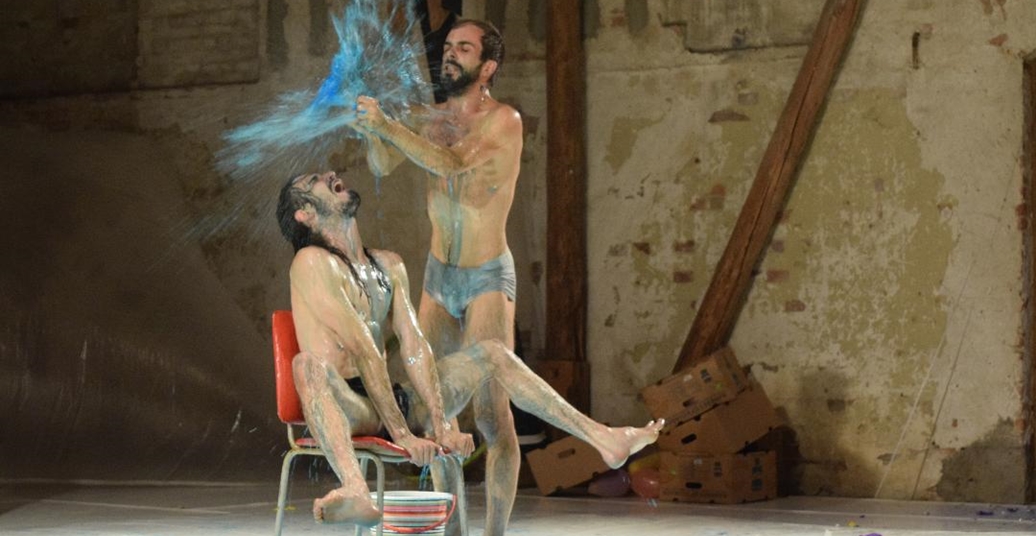“Tropical Escape” sees Csaba Molnár and Márcio K. Canabarro explore the politics of utopia, and the power of silliness.
Welcome to Utopia. It’s a place where you can be a prancing faun one moment, and a diva shrieking at your maid in Italian the next. When you burst a balloon, it might release a cloud of talcum powder into the air, or it might deposit a lipstick, knife, or banana into your lap. It’s likely that you will end up covered in paint, but don’t worry – it mixes in well with all the talcum powder and half-chewed banana. Norms are taboo, but everything else is fair game. Welcome to “Tropical Escape”.
Audiences are notoriously hard to shock nowadays – especially in Berlin. So when Debussy’s Prélude à l’après-midi d’un faune begins to play, and Csaba Molnár and Márcio K. Canabarro strike the iconic pose from Nijinsky’s 1912 ballet, it seems unlikely they will provoke the same allegations of obscenity as the original. And this is despite the fact that they are dressed only in two pairs of sheer tights each; one for their legs and the other for their heads, stuffed with brightly coloured balloons to form horns and hooves. Half human, half latex, these are hybrids befitting of a modern-day mythology.
Molnár and Canabarro ricochet from one scene to the next, pulling out a dizzying array of props and making one hell of a mess. The result is kitsch, fast-moving, subversive and very, very funny. They use each other’s inflatable horns as phalluses, in a cabaret-like fusion of the grotesque and the sensual. Exchanging the faun costumes for briefs, they lip-sync to melodramatic movie scenes in Spanish and Italian, gleefully camping it up. To the soundtrack from an opposite-sex porn film, they execute Cunningham-inspired movements, repurposing the grunts and moans as musical cues, then appropriating every overblown expletive as an expression of anger, annoyance, or pain.
They paste together a bizarre collage that strikes me as surreal, but far from nonsensical – the politics underpinning their queer reimaginings and reframing of sex, their bodies, and gender shines through. By using escapism as a form of utopian thought, we can deviate as far from the norm as our imaginations will allow, enabling us to question even the most deep-rooted of conventions. And let me just say one more time – the performance is very, very funny. By filtering out the grit of ‘normality’, Molnár and Canabarro deconstruct, remould, and polish our shared reality, offering it back to us reshaped into a glitteringly gaudy jewel. A jewel fit for the most anarchic of drag queens.
Towards the end of the performance, Molnár and Canabarro deliver a short lecture, detailing their creative process and some of their inspirations. They have a long list of references, from academics to artists; Paul B. Preciado, Karen Finley, Virginie Despentes, Fred Herko … They make a point of acknowledging the legacy of colonialism, Orientalism, and patriarchal oppression within the development of Eurocentric art. I ask myself if this is motivated by an element of self-justification? I wonder, is it perhaps because they present as two white, cisgender men, that they want to vocalise something they feel is not visually represented on stage? It would be a valid stance to take but, for me personally, the perceptive subversion inherent in the work speaks for itself.
As they talk about the revolutionary nature of utopian endeavour, and the powerful potential of queer failure, I am invigorated by the thought that disruption can be this much fun. Dance for the world you want, not the world you have.




